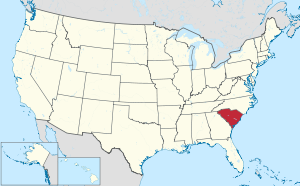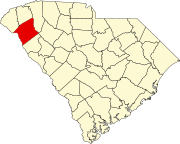Anderson County, South Carolina: Difference between revisions
→Government: Posted presidential data to 1900 |
|||
| Line 327: | Line 327: | ||
* [http://www.tctc.edu/ Tri-County Technical College] |
* [http://www.tctc.edu/ Tri-County Technical College] |
||
* {{osmrelation|1357072}} |
* {{osmrelation|1357072}} |
||
* [https://www.rootsandrecall.com/anderson/ Anderson County history and images] |
|||
{{Geographic Location |
{{Geographic Location |
||
Revision as of 09:46, 14 August 2017
Anderson County | |
|---|---|
 Anderson County Courthouse | |
 Location within the U.S. state of South Carolina | |
 South Carolina's location within the U.S. | |
| Coordinates: 34°31′N 82°38′W / 34.52°N 82.64°W | |
| Country | |
| State | |
| Founded | December 20, 1826 |
| Named for | Robert Anderson |
| Seat | Anderson |
| Largest city | Anderson |
| Area | |
| • Total | 757 sq mi (1,960 km2) |
| • Land | 715 sq mi (1,850 km2) |
| • Water | 42 sq mi (110 km2) 5.5% |
| Population | |
| • Estimate (2015) | 194,692 |
| • Density | 262/sq mi (101/km2) |
| Time zone | UTC−5 (Eastern) |
| • Summer (DST) | UTC−4 (EDT) |
| Congressional district | 3rd |
| Website | www |
Anderson County is a county located in the U.S. state of South Carolina. As of the 2010 census, its population was 187,126.[1] Its county seat is Anderson.[2] Named for Revolutionary War leader Robert Anderson, the county is located in northwestern South Carolina, along the Georgia border.
Anderson County is included in the Greenville-Anderson-Mauldin, SC Metropolitan Statistical Area.
Anderson County contains 55,950-acre (226 km2) Lake Hartwell, a U.S. Army Corps of Engineers lake with nearly 1,000 miles (2,000 km) of shoreline for residential and recreational use. The area is a growing industrial, commercial and tourist center. It is the home of Anderson University, a private, selective comprehensive university of approximately 3,000 undergraduate and graduate students.
Geography
According to the U.S. Census Bureau, the county has a total area of 757 square miles (1,960 km2), of which 715 square miles (1,850 km2) is land and 42 square miles (110 km2) (5.5%) is water.[3] Anderson County is in the Savannah River basin and the Saluda River basin.
Adjacent counties
- Pickens County – north
- Greenville County – northeast
- Laurens County – east
- Abbeville County – south
- Elbert County, Georgia – southwest
- Hart County, Georgia – west
- Oconee County – northwest
Major highways
Demographics
| Census | Pop. | Note | %± |
|---|---|---|---|
| 1830 | 17,169 | — | |
| 1840 | 18,493 | 7.7% | |
| 1850 | 21,475 | 16.1% | |
| 1860 | 22,873 | 6.5% | |
| 1870 | 24,049 | 5.1% | |
| 1880 | 33,612 | 39.8% | |
| 1890 | 43,696 | 30.0% | |
| 1900 | 55,728 | 27.5% | |
| 1910 | 69,568 | 24.8% | |
| 1920 | 76,349 | 9.7% | |
| 1930 | 80,949 | 6.0% | |
| 1940 | 88,712 | 9.6% | |
| 1950 | 90,664 | 2.2% | |
| 1960 | 98,478 | 8.6% | |
| 1970 | 105,474 | 7.1% | |
| 1980 | 133,235 | 26.3% | |
| 1990 | 145,196 | 9.0% | |
| 2000 | 165,740 | 14.1% | |
| 2010 | 187,126 | 12.9% | |
| 2016 (est.) | 196,569 | [4] | 5.0% |
| U.S. Decennial Census[5] 1790–1960[6] 1900–1990[7] 1990–2000[8] 2010–2013[1] | |||
As of the 2010 United States Census, there were 187,126 people, 73,829 households, and 51,922 families residing in the county.[9] The population density was 261.6 inhabitants per square mile (101.0/km2). There were 84,774 housing units at an average density of 118.5 per square mile (45.8/km2).[10] The racial makeup of the county was 80.1% white, 16.0% black or African American, 0.8% Asian, 0.3% American Indian, 1.3% from other races, and 1.5% from two or more races. Those of Hispanic or Latino origin made up 2.9% of the population.[9] In terms of ancestry, 15.9% were American, 13.6% were Irish, 10.8% were English, and 10.2% were German.[11]
Of the 73,829 households, 33.3% had children under the age of 18 living with them, 51.1% were married couples living together, 14.5% had a female householder with no husband present, 29.7% were non-families, and 25.4% of all households were made up of individuals. The average household size was 2.50 and the average family size was 2.98. The median age was 39.7 years.[9]
The median income for a household in the county was $42,871 and the median income for a family was $53,229. Males had a median income of $41,885 versus $30,920 for females. The per capita income for the county was $22,117. About 12.4% of families and 15.8% of the population were below the poverty line, including 23.0% of those under age 18 and 10.2% of those age 65 or over.[12]
Government
| Year | Republican | Democratic | Third Parties |
|---|---|---|---|
| 2016 | 69.9% 56,232 | 26.2% 21,097 | 3.9% 3,154 |
| 2012 | 67.5% 48,709 | 31.0% 22,405 | 1.5% 1,098 |
| 2008 | 66.0% 48,690 | 32.7% 24,132 | 1.3% 965 |
| 2004 | 67.0% 43,355 | 32.0% 20,697 | 1.0% 670 |
| 2000 | 63.2% 35,827 | 34.6% 19,606 | 2.2% 1,248 |
| 1996 | 52.7% 24,137 | 38.2% 17,460 | 9.1% 4,172 |
| 1992 | 51.7% 24,793 | 33.5% 16,072 | 14.8% 7,106 |
| 1988 | 67.6% 25,939 | 32.0% 12,281 | 0.4% 163 |
| 1984 | 69.5% 24,123 | 29.8% 10,324 | 0.7% 244 |
| 1980 | 44.4% 15,667 | 53.3% 18,801 | 2.4% 837 |
| 1976 | 33.1% 9,496 | 66.3% 19,002 | 0.5% 156 |
| 1972 | 75.2% 17,514 | 22.5% 5,241 | 2.3% 537 |
| 1968 | 24.3% 5,661 | 22.4% 5,218 | 53.2% 12,384 |
| 1964 | 41.9% 8,398 | 58.2% 11,670 | |
| 1960 | 21.7% 3,845 | 78.3% 13,901 | |
| 1956 | 14.8% 2,186 | 76.8% 11,344 | 8.4% 1,241 |
| 1952 | 22.3% 3,338 | 77.8% 11,664 | |
| 1948 | 2.6% 105 | 64.1% 2,581 | 33.3% 1,342 |
| 1944 | 3.0% 89 | 90.2% 2,687 | 6.8% 202 |
| 1940 | 2.2% 86 | 97.8% 3,763 | |
| 1936 | 0.6% 26 | 99.4% 4,025 | |
| 1932 | 0.7% 30 | 99.3% 4,067 | |
| 1928 | 3.3% 61 | 96.7% 1,780 | |
| 1924 | 0.6% 9 | 99.2% 1,455 | 0.2% 3 |
| 1920 | 1.3% 33 | 98.7% 2,489 | |
| 1916 | 0.2% 6 | 99.5% 2,609 | 0.3% 7 |
| 1912 | 1.1% 25 | 95.3% 2,158 | 3.6% 82 |
| 1904 | 3.3% 66 | 96.7% 1,952 | |
| 1900 | 3.5% 68 | 96.5% 1,858 |
Anderson County has a Council-Administrator form of government under South Carolina law. County Council members are elected from seven single-member districts for two-year terms. All seven council seats are open for election every two years.
Anderson County Councilmen are:
- District 1: Craig Wooten (R-North Anderson)
- District 2: Gracie Floyd (D-South & East Anderson)
- District 3: Ray Graham (R-Belton/Starr/Iva area)
- District 4: Tom Allen (R-Pendleton area)
- District 5: Tommy Dunn (R-West Anderson)
- District 6: Ken Waters (R-Powdersville area)
- District 7: M. Cindy Wilson (R-Williamston/Honea Path area)
The Anderson County Administrator is Rusty Burns.
Operations
Anderson County has ten divisions:
- Administration
- Parks, Recreation & Tourism
- Central Services
- Economic Development
- Emergency Services
- EMS & Special Operations
- Environmental Services
- Finance
- Planning
- Transportation
Economy
Early industry in the county was textile mills, processing southern cotton. In the 21st century, industry has divesified with more than 230 manufacturers, including 22 international companies. The top major industries in Anderson include manufacturers of automotive products, metal products, industrial machinery, plastics, publishing and textiles. Two industries that many times interconnect are the plastic and automotive sectors. There are more than 27 BMW suppliers in the upstate, which is recognized internationally as an automotive supplier hub. The plastic industry has a strong presence in the upstate, with 244 plastic companies located within the 10 counties of the northwest corner of SC. Anderson County has 11 automotive suppliers and is a major player in the plastic industry, with 27 plastic companies located within its borders.[14]
Communities
Cities
- Anderson
- Belton
- Clemson (mostly in Pickens County)
- Easley (mostly in Pickens County)
Towns
- Honea Path (partly in Abbeville County)
- Iva
- Pelzer
- Pendleton
- Starr
- West Pelzer
- Williamston
Census-designated places
- Centerville
- Fair Play (mostly in Oconee County)
- Homeland Park
- Northlake
- Piedmont (partly in Greenville County)
- Powdersville
Unincorporated communities
- Aaron
- La France
- Sandy Springs
- Townville (partly in Oconee County)
- Craytonville
See also
References
- ^ a b "State & County QuickFacts". United States Census Bureau. Retrieved November 22, 2013.
- ^ "Find a County". National Association of Counties. Archived from the original on 2011-05-31. Retrieved 2011-06-07.
{{cite web}}: Unknown parameter|deadurl=ignored (|url-status=suggested) (help) - ^ "2010 Census Gazetteer Files". United States Census Bureau. August 22, 2012. Retrieved March 15, 2015.
- ^ "Population and Housing Unit Estimates". Retrieved June 9, 2017.
- ^ "U.S. Decennial Census". United States Census Bureau. Archived from the original on May 12, 2015. Retrieved March 15, 2015.
{{cite web}}: Unknown parameter|deadurl=ignored (|url-status=suggested) (help) - ^ "Historical Census Browser". University of Virginia Library. Retrieved March 15, 2015.
- ^ Forstall, Richard L., ed. (March 27, 1995). "Population of Counties by Decennial Census: 1900 to 1990". United States Census Bureau. Retrieved March 15, 2015.
- ^ "Census 2000 PHC-T-4. Ranking Tables for Counties: 1990 and 2000" (PDF). United States Census Bureau. April 2, 2001. Retrieved March 15, 2015.
- ^ a b c "DP-1 Profile of General Population and Housing Characteristics: 2010 Demographic Profile Data". United States Census Bureau. Retrieved 2016-03-09.
- ^ "Population, Housing Units, Area, and Density: 2010 – County". United States Census Bureau. Retrieved 2016-03-09.
- ^ "DP02 SELECTED SOCIAL CHARACTERISTICS IN THE UNITED STATES – 2006–2010 American Community Survey 5-Year Estimates". United States Census Bureau. Retrieved 2016-03-09.
- ^ "DP03 SELECTED ECONOMIC CHARACTERISTICS – 2006–2010 American Community Survey 5-Year Estimates". United States Census Bureau. Retrieved 2016-03-09.
- ^ http://uselectionatlas.org/RESULTS
- ^ "Anderson County Development Partnership". Andersonpartnership.com. Retrieved 2011-12-22.[permanent dead link]

